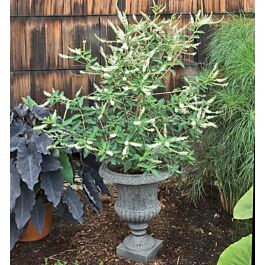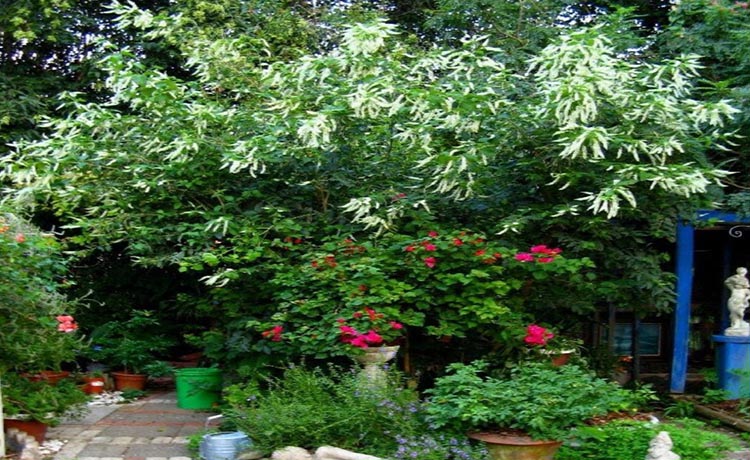Sweet Almond Bush: The Droughttolerant Shrub With A Sweet Almond Scent
Title: Sweet Almond Bush: The Drought-Tolerant Shrub With a Sweet Almond Scent
Introduction:
The sweet almond bush (Aloysia virgata) is a beautiful and fragrant shrub that is native to Argentina. It is a member of the verbena family and is known for its long, slender branches that are covered in small, white flowers. The flowers have a sweet, almond-like scent that can be enjoyed all summer long.
Sweet almond bushes are relatively easy to care for and can be grown in a variety of climates. They are drought-tolerant and can thrive in full sun or partial shade. Sweet almond bushes are also relatively pest- and disease-resistant.
If you are looking for a beautiful and low-maintenance shrub to add to your garden, the sweet almond bush is a great option. It is sure to add a touch of sweetness and elegance to your landscape.
Main Content:
Plant Description
The sweet almond bush is a fast-growing shrub that can reach heights of 10-15 feet. It has slender, upright branches that are covered in small, opposite leaves. The leaves are dark green and have a slightly glossy appearance.
The sweet almond bush blooms from midsummer to fall. The flowers are small and white, and they are arranged in long, terminal spikes. The flowers have a sweet, almond-like scent that can be enjoyed from a distance.
Growing Conditions
Sweet almond bushes are relatively easy to care for. They prefer full sun, but they can also tolerate partial shade. They are drought-tolerant and can thrive in poor soils. Sweet almond bushes are also relatively pest- and disease-resistant.
Pests and Diseases
Sweet almond bushes are relatively resistant to pests and diseases. However, they can be susceptible to aphids, spider mites, and scale insects. These pests can be controlled with insecticidal soap or neem oil.
Propagation
Sweet almond bushes can be propagated from seed or cuttings. Seeds can be sown in the spring or fall. Cuttings can be taken in the spring or summer.
Uses
Sweet almond bushes are beautiful and fragrant shrubs that can be used in a variety of ways. They can be used as a focal point in a garden, or they can be planted in groups to create a hedge or screen. Sweet almond bushes are also attractive in containers.
The sweet almond bush's fragrant flowers can be used to make potpourri or essential oil. The leaves can also be used to make tea.
Conclusion
The sweet almond bush is a beautiful and fragrant shrub that is easy to care for. It is a great choice for gardeners who are looking for a low-maintenance plant that will add a touch of sweetness to their landscape.
The sweet almond bush (Aloysia virgata) is a fast-growing, evergreen shrub that is native to South America. It is known for its fragrant white flowers, which bloom from spring to summer. The sweet almond bush is a popular choice for butterfly gardens, as it attracts a variety of butterflies and other pollinators. It is also relatively easy to care for, making it a good choice for beginner gardeners.
If you are interested in learning more about the sweet almond bush, please visit Home Gardening. This website provides detailed information on the plant's care, growth requirements, and pest and disease resistance. You can also find photos and videos of the sweet almond bush in bloom.
FAQ of sweet almond bush
- How do you root a sweet almond bush?
Sweet almond bushes can be propagated by taking cuttings in spring or early summer. To do this, cut a healthy, 6- to 8-inch (15- to 20-cm) stem from the bush. Make sure to cut just below a node, which is where new growth will emerge. Remove the lower leaves from the cutting, and then dip the cut end in rooting hormone. Plant the cutting in a well-draining potting mix and water it thoroughly. Place the cutting in a shady spot and keep the soil moist. In a few weeks, you should see roots forming. Once the roots are established, you can transplant the cutting into a larger pot or into the ground.
- What is the use of sweet almond plant?
Sweet almond plants are grown for their ornamental value, as well as for their edible nuts and oil. The nuts can be eaten raw or roasted, and the oil is used in cooking, cosmetics, and soaps. Sweet almond oil is also used in traditional medicine to treat a variety of ailments, including constipation, cancer, and skin problems.
- What are the different types of sweet almond bush?
There are two main types of sweet almond bush: the peach almond and the bitter almond. Peach almonds are the most common type of sweet almond bush, and they produce sweet, edible nuts. Bitter almonds are not edible, but they can be used to make almond oil and other products.
- What are the care requirements for sweet almond bush?
Sweet almond bushes are relatively easy to care for. They prefer full sun and well-drained soil. They should be watered regularly, especially during the hot summer months. Sweet almond bushes are not very susceptible to pests or diseases, but they may be affected by aphids, scale, and leaf spot.
- How long does it take for a sweet almond bush to bear fruit?
Sweet almond bushes typically start to bear fruit after 3 to 4 years of growth. The amount of fruit that a bush produces will depend on the variety of bush, the climate, and the amount of care that the bush receives.
- How do you prune a sweet almond bush?
Sweet almond bushes should be pruned in late winter or early spring. The goal of pruning is to remove dead, diseased, or damaged branches, as well as to shape the bush. You can also prune sweet almond bushes to encourage more flowering and fruiting.
Image of sweet almond bush
- A close-up of the sweet almond bush's leaves and flowers. The leaves are small and oval-shaped, and the flowers are white and fragrant.
- A full-size image of a sweet almond bush in bloom. The bush is covered in white flowers, and the leaves are a dark green.

- A sweet almond bush in a pot. The bush is about 3 feet tall and has several branches. The leaves are a dark green, and the flowers are white.

- A sweet almond bush in a garden. The bush is about 5 feet tall and has several branches. The leaves are a dark green, and the flowers are white.

- A sweet almond bush in a hedgerow. The bush is about 7 feet tall and has several branches. The leaves are a dark green, and the flowers are white.

- A sweet almond bush in the wild. The bush is about 10 feet tall and has several branches. The leaves are a dark green, and the flowers are white.
- A sweet almond bush with ripe fruits. The fruits are small and brown, and they are clustered together on the branches.

- A sweet almond bush in the fall. The leaves are a golden brown color, and the fruits are still on the branches.

- A sweet almond bush in the winter. The leaves have fallen off, and the branches are bare.

- A sweet almond bush in a vase. The bush is about 2 feet tall and has several branches. The leaves are a dark green, and the flowers are white.


Post a Comment for "Sweet Almond Bush: The Droughttolerant Shrub With A Sweet Almond Scent"